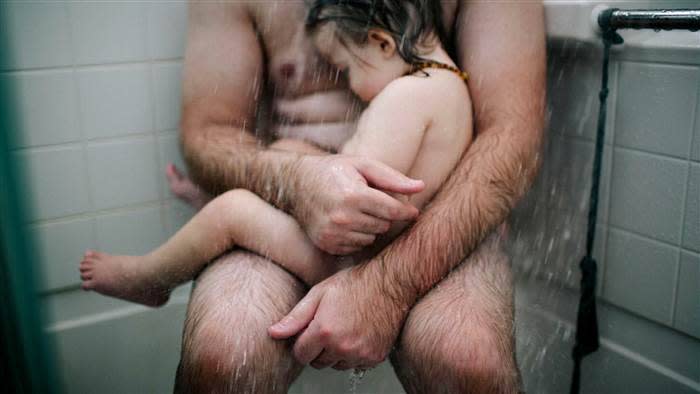The Science Behind Skin-to-Skin Contact
Skin-to-skin contact makes all kinds of sense for premature infants.
Two photos of dads snuggling with their infants have gone viral this week, reigniting discussion about the power of skin-to-skin contact between parents and babies.
“I snapped a couple of pictures,” Heather Whitten, the Arizona photographer who captured an image of her husband holding their feverish 1-year-old in the shower, told Today. “It was just beautiful. It was not surprising or anything out of the ordinary; it’s how he has always been with the kids.” What Whitten said she likes about the photo — which she took in 2014 but reposted to Facebook recently, where it has been shared more than 38,000 times — is that it shows “it is OK to get naked with your son and nurture him. … The important thing is really taking care of your kiddos.“
Related: Facebook Blocks Photo Featuring Plus-Size Model Tess Holliday From Being Promoted
Another image — this one of a father in a Swedish hospital enjoying some skin-to-skin time with one of his premature twins (as his young son follows suit with the other) — has also gotten plenty of buzz. Also a repost, the photo originally was shared last year by a Danish family advocacy organization. It is now reaching viral proportions, with more than 22,000 shares after a South African organization posted it on Facebook last week.
The caption, translated from Danish, explains a Swedish practice in which babies weighing around 1.5 pounds are placed on a parent’s bare chest instead of in an incubator. “[Swedish professor] Uwe Ewald points out that the parent’s chest regulates the temperature better than an incubator,” it reads. “Skin-to-skin contact helps the baby to breathe better. The child becomes calmer and gains weight faster. Research shows that parents’ bacterial flora — compared with hospital bacteria — reduces the risk of serious infections in these delicate children.”

The Internet went crazy for this image of a dad comforting his sick son. (Photo: Heather Whitten)
A 2015 study published in the journal Pediatrics confirmed that for preterm newborns, skin-to-skin snuggling — sometimes referred to as “kangaroo care” — can lower the risk of sepsis, a blood infection, and boost babies’ odds of survival by improving vital signs. While some U.S. hospital neonatal care units do allow the practice, it’s not the standard. But given the scientific evidence, senior study author Grace Chan told CBS News at the time that it would “definitely be worthwhile to expand the practice here.”
It would certainly be well-received by new parents, judging by the theme of the nearly 1,000 comments on the recent post. “My daughter was born at 25 weeks. I was constantly begging to do skin to skin,” shared one woman. “Many of the nurses acted like it was a big bother to them. … It is so hard to have other people tell you that you can’t hold your own baby.” Others reported the practice had helped them. “We practiced this ‘kangaroo’ care regularly with my micro preemies. One born at 25.3 weeks and the other at 23.5 weeks they are now strong young adults at 20 & 19,” noted one. Another added, “My babies (twins) were born at 24 weeks. … We did this at every opportunity. Their stats rose, breathing dependency reduced and they and I got a whole lot happier.”
Related: I Tried 7 Natural Deodorants and a Few of Them Actually Worked
Another skin-to-skin benefit is that it has been shown to calm parents down, according to research. “It seems to help the mothers too,” Anne Bigelow, a professor and researcher of developmental psychology, told Scientific American several years ago. “It reduces their stress level — they report lower levels of depression, they seem to be able to be more sensitive to their baby’s cues, and the babies are more responsive to the mother through the whole first three months. They’re recognizing their mother earlier, so the relationship between the mother and baby is off to a facilitated start. It works the same way with fathers too.”
In the U.K., many government hospitals have officially begun encouraging fathers to strip their shirts off in the delivery room and practice skin-to-skin contact with their newborns. And in 2007, a small Swedish study showed that fathers who stepped in for post-C-section moms and held their babies against their skin wound up with infants who were more easily soothed.
As for the first photo, with the father in the shower with his son — who ended up with a diagnosis of salmonella — Whitten had originally shared it in a photo class, and observers misinterpreted it as being sexual. She had also previously shared it on Facebook, twice, only to have it banned and then reinstated. But she had concerns about how it would be seen from the start. “I wanted to take it down just because I thought it would get blown out of proportion,” she says. “I thought the point was getting missed.”
It seems to be hitting the mark this time around, though, with more than 25,000 comments, many of them as supportive as this one: “Your photo does what every photographer hopes theirs will do. It tells the story. A love story told by a good dad taking care of his sick child and a mom who only wanted to share that inspiring love with those of us who ‘get it.’ Don’t let the closed minded deter you! It’s beautiful!”
Let’s keep in touch! Follow Yahoo Beauty on Facebook, Twitter, Instagram, and Pinterest. Have a beauty story you’d like to share with us? Email ybeautystories@yahoo.com.



